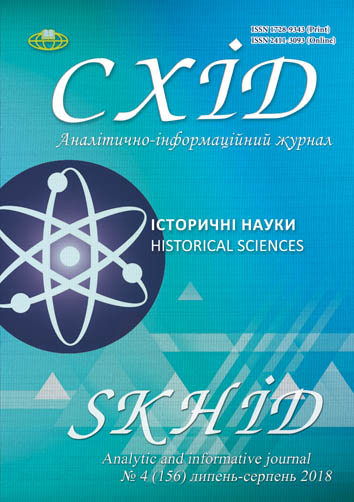Manipulation by visual images in ideological concepts or how the G. Potiomkin's image was "cleaned up"
DOI:
https://doi.org/10.21847/1728-9343.2018.4(156).143499Keywords:
Northern Black Sea Region, Russian-Turkish wars, engraving, ideology, image, design.Abstract
It is noted in the article that the graphic drawing from the end of the 18th century was actively used in forming public opinion through correction of images. With powerful levers, the state influenced on the subject of the work of art, formed the idea of the plot and the interpretation which it needed, introducing a certain set of ideas into the mass consciousness.
The peculiarities of producing and plotting works of painting and graphics covering the events of the Russian-Turkish wars of the last quarter of the 18th century, speak about the policy of the establishment of G. Potemkin as a key figure in promoting the Russian Empire to the South during the implementation of the ideological concept of the Greek project.
On the basis of the analysis of works of painting and graphics devoted to the siege of Ochakov in 1788, the process of forming the image of G. Potemkin is observed against the background of his unpopular measures to take the fortress. After Ochakov's assault, custom-made oil paintings by F. Kazanov "Assault of Ochakov", A. Barsh's engravings and I. Willle's engraving series devoted to the key themes of the process of taking the fortress, appeared. In addition, there are full-time eyewitnesses of the assault on the fortress of the artist M. Ivanov.
The conclusions indicate that it was during the days of Catherine II that military plots were spreading in graphic drawing, giving way only to the dominant direction - the portrait genre. The analysis of the works of painting and engravings devoted to the siege of Ochakov in 1788 suggests a certain transformation of historical reality, which was fixed by M. Ivanov in the works of A Barsh, and the construction of the positive image of G. Potemkin in the works of I. Wille and F. Kazanov. With the help of these means of formation of conditional reality, they tried to overcome the "negative consequences" for the reputation of G. Potemkin, which appeared during the Ochakov siege.
References
Beskrovny, G., 1980. Alexander Vasilievich Suvorov: To the 250th Anniversary of His Birth. Moscow: Nauka, 280 р. (rus).
Anting,I., 1800. Life and Military Actions of the Generalissimo, Prince of the Italian Earl Suvorov-Rymninskiy. St. Petersburg: Maxim Parpur publishing house, Ch. 2. 192 p. (rus).
Bonnell, V., 2007. Peasant Woman in the Political Art of the Stalin Era. Soviet Social Policy of the 1920s-1930s: Ideology and Everyday Life. Moscow: Variant: 262-294 (rus)
Brikner, A., 1891. Potemkin. St. Petersburg: The edition of K. L. Rikker, 276 р.
Catherine II and Potemkin. 2010. Personal Correspondence (1769-1791). Moscow: Direct-Media, 377-378.
Zorin, A., 2001. Feeding the Double-Headed Eagle. Russian Literature and State Ideology in the last third of the XVIII - first third of the XIX century. Moscow: New Literary Review, 416 р.
Lopatin, S., 1992. Potemkin and Suvorov. Moscow: Science, 288 р.
Nikolsky, G., 1949. Suvorov's "Science of winning". Moscow: Ministry of the Armed Forces of the USSR, 87 р.
Orlova, G., 2009. "Maps for the Blind": Politics and Politicization of View in the Stalin Era. Visual anthropology: Modes of Visibility Under Socialism. Moscow: Variant, Р. 57-105.
Osipov, K., 1949. Suvorov. Riga: Litgosizdat, URL: http://adjudant.ru/suvorov/osipov08.htm
Petrov, A. 1880. The Second Turkish War in the Reign of Empress Catherine II. 1787-1791. St. Petersburg: Type. R. Golike, Volume I. 300 р.
Proskurina, V., 2006. Myths of the Empire. Literature and Power in the Era of Catherine II. Moscow: New Literary Review, 328 р.
Tranchan, de L., Leger, M.-F. 1811. Life of General-Field Marshal Prince Grigory Alexandrovich Potemkin Tavrichesky. T.2. St. Petersburg: Type. Ivan Glazunov, 140 р.
Tsebrikov, R. 1895. Around Ochakov, 1788 (Diary of an Eyewitness). Russian Antiquity. 84 (No. 9). Р. 169.
Mitchell, W., 2002. Showing Seeing: a Critique of Visual Culture. Journal of Visual Culture. Vol. 1. № 2. 258 р.
Downloads
Published
How to Cite
Issue
Section
License
Copyright (c) 2018 Viktor Filas

This work is licensed under a Creative Commons Attribution-NonCommercial-NoDerivatives 4.0 International License.
1. Authors bear responsibility for the accuracy of facts, quotations, numbers and names used.
2. Manuscripts are not sent back.
3. The publisher does not always agree with the authors' opinion.
4. The authors reserve the right to authorship of the work and pass the first publication right of this work to the journal under the terms of a Creative Commons Attribution Non-Commercial License, which allows others to freely distribute the published research with the obligatory reference to the authors of the original work and the first publication of the work in this journal.
5. The authors have the right to conclude separate supplement agreements that relate to non-exclusive work distribution in the form in which it has been published by the journal (for example, to upload the work to the online storage of the journal or publish it as part of a monograph), provided that the reference to the first publication of the work in this journal is included.

